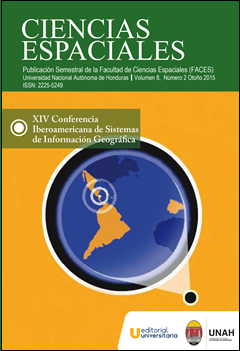Major changes in land cover and systematic analysis of transitions in an area of western Honduras
DOI:
https://doi.org/10.5377/ce.v8i2.2093Keywords:
Land cover, categorical changes, systematic transitions, Honduras, WestAbstract
The aim was to apply geographic information technologies to identify significant changes in land cover and analyze dominant signals linked to systematic processes of changes in western Honduras. Periods were analyzed before and after Hurricane Mitch that hit Central America in 1998. We used maps of 1991, 1995, 2003 and 2006 classified in: mixed forest, pine, shrubs, herbaceous, agriculture, urban and bare soil. The 1991 and 1995 and 2003 and 2005 were compared to build cross-tabulation matrices that were analyzed separately to identify persistence, gains and losses by category. We calculated net change, swap, total change; and the transitions between categories. As a result it was found that for 1991-1995 the largest net change was in agriculture (9.54%), shrubs (6.07%) and pine (4.92%); for 2003- 2006, in shrubs (5.54%), herbaceous (4.39%) and mixed forest (3.13%). Between 1991 -1995 the swap occurred in most of the categories: mixed forest (20.15%), agriculture (18.86%), shrubs (13.56%), pine (12.32%) and bare soil (11.96%); and between 2003 -2006 in: agriculture (23.98%), pine (15.30%), bare soil (14.77%), scrubs (13.47) and mixed forest (8.22%). The results show a high dynamic landscape change, 52.57% in 1991-1995 and 48.78% in 2003-2006. The main systematic transitions between 1991 -1995 were: mixed forest to pine and shrubs to agriculture, the first due to the expulsion of large sawmills in the area, the latter to the advance of the agricultural frontier. Between 2003 -2006 the main systematic transitions were: pine to mixed forest and shrubs to pine, the first due to the economic importance that there acquired other species, the second to the depletion of productive capacity of shrubs that became most economically valuable species, as pine. These latest trends reveal potential of natural regeneration of the forest and human protection and economic intentions.
Revista Ciencias Espaciales, Volumen 8, Número 2 Otoño, 2015; 469-492
Downloads
1053




